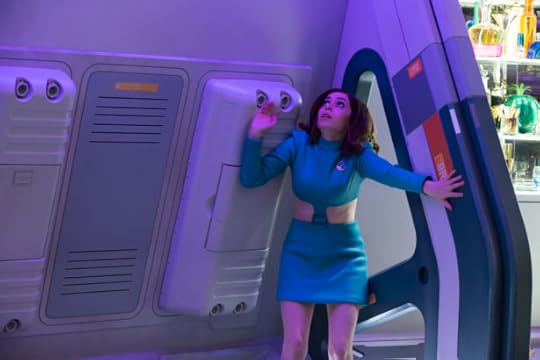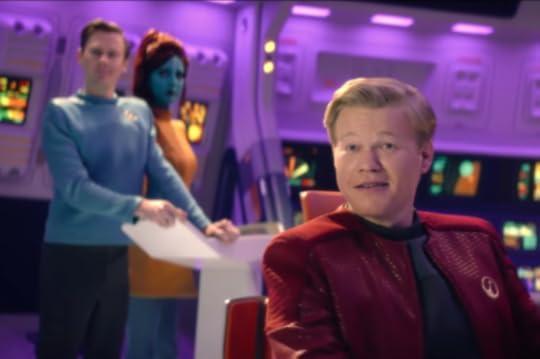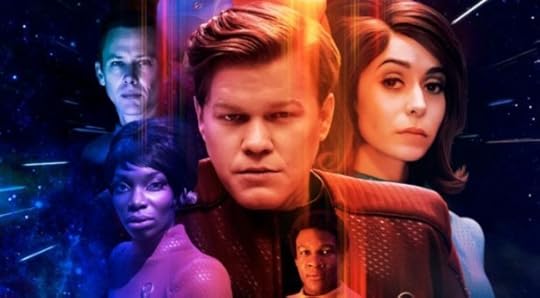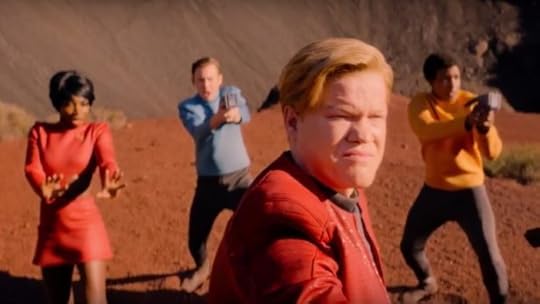Chris Hardwick's Blog, page 1862
December 29, 2017
New FANTASTIC BEASTS 2 Photos Feature a Very Handsome Young Dumbledore
We’re still 11 months away from the next installment in the Fantastic Beasts franchise, with The Crimes of Grindelwald set to hit theaters until November. But in the great tradition of Harry Potter we’re using that time to try to solve the mystery of what to expect from the film. While the two newest photos from the movie aren’t eager to give up any secrets, we’ve still managed to unlock some insights from them. Although it doesn’t take a brilliant detective to realize young Albus Dumbledore was one handsome wizard.
Warner Bros. released two new photos from the film, and each features one of the two former friends who will eventually become rivals, Dumbledore and Grindelwald. Let’s start with Dumbledore, because damn, the future Hogwarts Headmaster was a good-looking younger man.

Beyond that, there are a couple of sneaky hints as to what might be going on here. First is where and how he is sitting. Unless young Dumbledore was incredibly rude/a monster we’d imagine he’s sitting on his own desk, which means that might be his old office at Hogwarts when he was still just a Transfiguration professor. The stone walls behind resemble those of the wizarding school, and that’s the most logical place for him to be.
And while there’s no indication who the man behind him is, his very stylish clothes do resemble the costumes seen in the first movie set in New York City. That coat certainly screams big city fashion a lot more than it does school professor, so could he be a representative of MACUSA who has come to ask Dumbledore for help in capturing Grindelwald, who we know starts this second movie having escaped from imprisonment in America?
Dumbledore told Harry Potter he was reluctant to face his former friend for many years; their grand duel wouldn’t come to a pass until 1945. In this movie, Albus will ask Newt Scamander for help. This could be where Dumbledore decides to take a passive role in stopping Grindelwald, which could endanger many others.
Speaking of the evil Dark Wizard, the second photo shows Johnny Depp’s Grindelwald standing on a city street. This could be New York, London, Paris (three known setting for the film), or anywhere else in Europe. There’s not much to go on here when it comes to Grindelwald, but we do know something about the fashionable lady with him. That’s actress Poppy Corby-Tuech, who is playing Vinda Rosier, “one of Grindelwald’s most trusted followers, a loyal servant to his cause and often at his side.”

In the synopsis of the movie, Warner Bros. says Grindelwald “has set about gathering followers,” however the majority of them are “unsuspecting of his true agenda” of trying to “raise pure-blood wizards up to rule over all non-magical beings.” We might cause even greater enmity between Newt and his brother Theseus, who is engaged to Newt’s former love interest Leta LeStrange. In the movie “lines are drawn as love and loyalty are tested, even among the truest friends and family, in an increasingly divided wizarding world,” although we’re hopeful the brothers will reunite once Grindelwald’s real crimes come to light.
However, when it comes to Vinda Rosier she’s likely to be fully-aware of Grindelwald’s true plans. Not only because she is such a trusted associate, but because siding with evil wizards seems to run in the family. One of her descendants, Evan Rosier, became a Death Eater. Sirius Black proved your bloodline doesn’t always guarantee you’ll follow the same path as the rest of your family, but he was the exception to the rule.
Combined these photos seem to be highlighting the growing danger of one wizard, and the first initial, hesitant step by the only person who can stop him. It might not seem like a lot, but they are more pieces to the puzzle… one of which is very handsome.
But what do you make of these? What do you think they show? Accio your ideas in the comments below.
Images: Warner Bros.
The Real World Looks Very BLACK MIRROR-y in New Season 4 Promo
As 2017 comes to a close, we’ve got a brand new season of Black Mirror to enjoy on Netflix. Charlie Brooker‘s twisted anthology series has made a name for itself by offering dark reflections on our modern lives. And as you can see in Netflix’s new promo video for Black Mirror season four, the parallels between reality and fiction can become uncomfortable when they begin to blur together.
The trailer weaves the world of Black Mirror, in the form of clips and voiceover, with that of our own, showing via news snippets from the past year just how close we’re coming to living in our very own episode of Black Mirror. It’s a little troubling when the show itself feels like it is becoming less absurd than the events of our everyday lives. And if we’ve learned anything from seasons one, two, and three, there’s no easy way out of this vicious cycle.
Bleak though this message may be, it does make us want to dive right into the latest batch of Black Mirror episodes. If you’re hankering for some of the series’ trademark depressing-as-all-hell speculative science fiction, hop over to Netflix, and read our recaps for the series’ new season below.
What did you think about the new promo for Black Mirror? Let us know in the comment section below!
Images: Netflix
Read our recaps for Black Mirror season four!
“Arkangel” is a helicopter parent horror story
“U.S.S. Callister” is a takedown of toxic masculinity
“Metalhead” turns the apocalypse upside down
Black Mirror finds its heart with “Hang the DJ”
The past is inescapable in “Crocodile”
Is “Black Museum” the series’ cry for help?
THE LAST JEDI is Remarkably Similar to THE EMPIRE STRIKES BACK
Editor’s note: The following post and video contain massive spoilers for The Last Jedi, so read at your own peril.
If you thought The Last Jedi was “too different” from the original Star Wars trilogy, then think again. While the common online criticism of The Last Jedi leading us too far afield from the Star Wars stories we know and love may be true from a certain point of view, it’s also factually inaccurate. The Star Wars prequel trilogy was made to rhyme with events and echo themes of the original trilogy, and now that Disney’s sequel trilogy is two films deep, we can see that it honors the legacy of the original films the same way that the prequels did. (And all without the aid of a certain bumbling Gungan senator.)
The similarities between The Last Jedi and The Empire Strikes Back are myriad. While the two films are separated by the span of nearly 40 years, the imagery and plot devices employed by both are too numerous to discount as mere coincidence. Allow us to explain:
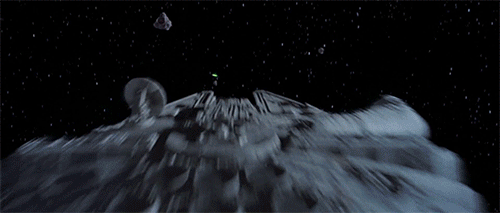
via Giphy
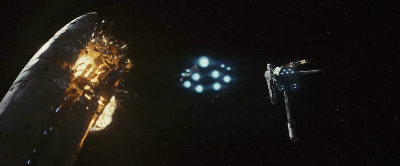
via Giphy
In both The Last Jedi and The Empire Strikes Back, we follow our heroes on a single ship, on the run through space from the Empire/First Order’s most powerful capital ships.
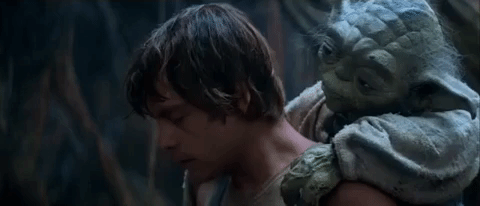
via Giphy
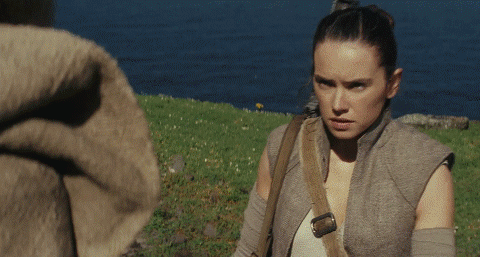
via Giphy
Meanwhile, Luke and Rey are off on remote planets, learning the ways of the Force from Jedi Masters who are pretty cagey about taking on new pupils at first.
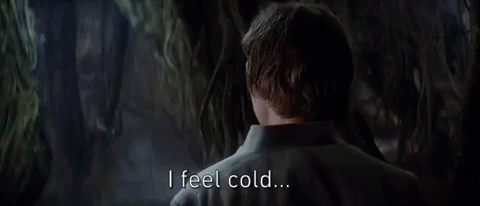
via Giphy
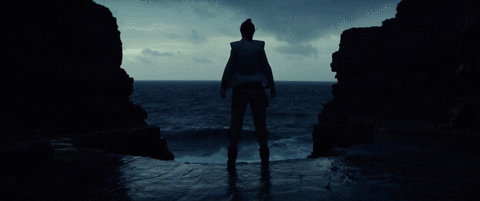
via Giphy
Both Luke and Rey are beckoned by the dark side to seek out shadowy caverns, only to be horrified by what they find therein.
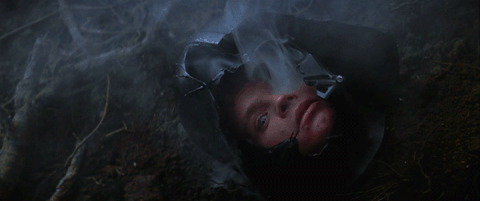
via Giphy
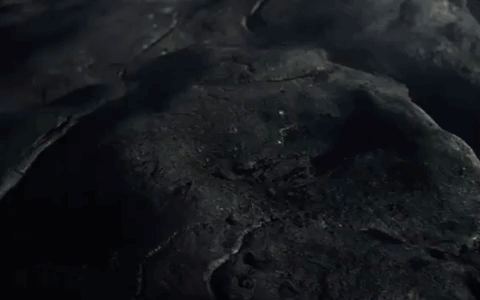
via Giphy
After brief periods of training, they both leave to rejoin the larger fight after experiencing Force-induced visions.

via Giphy
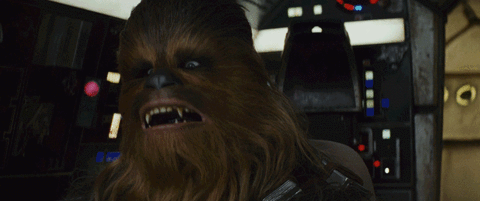
via Giphy
Our subplots take us to faraway, exotic locales—Cloud City on Bespin and the casinos of Canto Bight—full of smooth-talking shysters—Lando Calrissian and the Master Codebreaker (and even D.J. to a certain extent)—where our heroes only manage to escape because their droids save their butts.
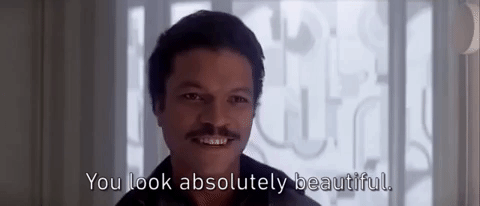
via Giphy
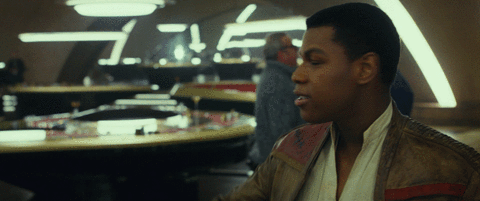
via Giphy
Luke and Rey confront Darth Vader and Kylo Ren, respectively. We even get a callback to Return of the Jedi in the turbolift to Snoke’s throne room when Rey implores Kylo Ren to turn back to the light, just as Luke did to his father decades earlier.
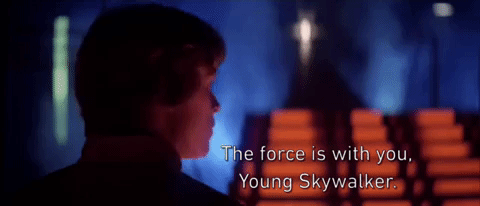
via Giphy
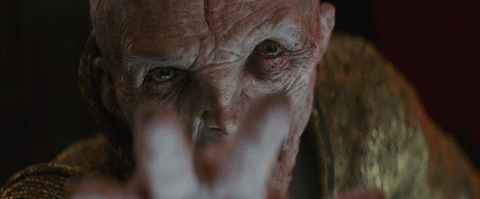
via Giphy
Then there’s the big lightsaber fight. After all is said and done, Darth Vader and Kylo Ren offer Luke and Rey the chance to rule the galaxy by their sides. They also reveal huge secrets about both characters’ parentage.
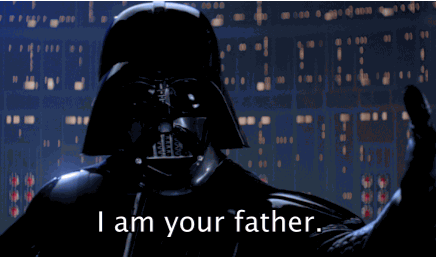
via Giphy
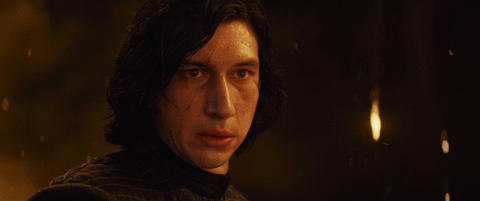
via Giphy
While Rey doesn’t get dismembered, both scenes pretty much end up the same way as both Luke and Rey refuse to join and rule the galaxy. By the end of the film, our heroes are batter, changed, and barely holding on, but they’re ready to keep fighting and hopeful for the future.
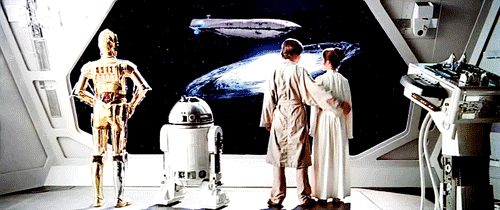
via Giphy
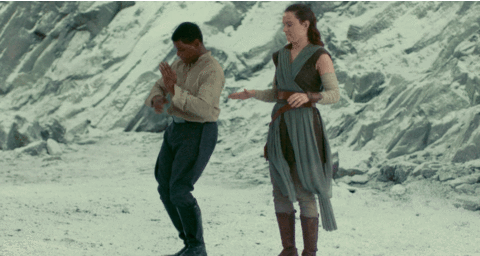
via Giphy
Are the plot points exactly the same?
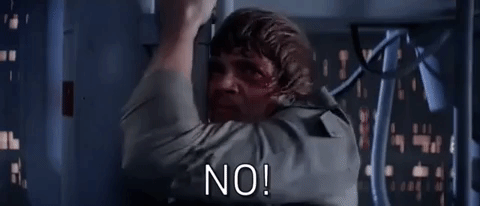
via Giphy
Of course they aren’t. The Last Jedi gives us fresh twists and turns, sending the franchise heading off in an entirely new direction, but the same Midi-chlorians that make up Star Wars‘ DNA are still present in The Last Jedi.
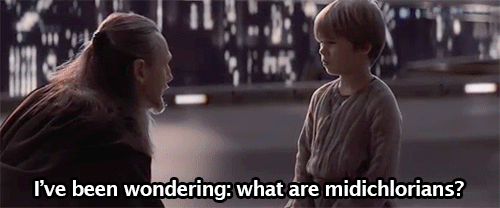
via Giphy
But what do you think? Does The Last Jedi mirror the events of The Empire Strikes Back and the original trilogy, or is this just an elaborate coincidence? Let us know your thoughts in the comments below.
Additional reporting and editing by Jesse B. Gill.
Dan Casey is the senior editor of Nerdist and the author of books about Star Wars and the Avengers. Follow him on Twitter (@DanCasey).
BLACK MIRROR’s “Crocodile” Proves There’s No Statute of Limitations on Sin
What’s the worst thing you’ve ever done? And what would you do to keep it hidden?
“Crocodile” is a long slog into a tell-tale heart of darkness. In her youthful fervor, Mia Nolan (Andrea Riseborough) abetted her boyfriend (Andrew Gower) in hiding the body of a cyclist he hit with his car while driving under a lot of influences. They never paid a price, but the universe has decided, 15 years later, to collect.
What’s most intriguing about this episode of Black Mirror is that the plot is completely laid out for us by the time Mia kills her old flame and orders a hotel porno to create a flimsy alibi. We know the insurance adjuster Shazi (played by Kiran Sonia Sawar) will eventually work her way to Mia. We know Mia’s memory will be on full display. What we don’t know is how she’ll respond, and that makes the journey like trudging in the muck toward a loaded gun. Director John Hillcoat, with the Western sensibilities of The Road and The Proposition, was the perfect choice to see this downward spiral through.
Instead of admitting her crimes and sleeping the sleep of the guilty, Mia chooses to go Walter White-ing all over the place. It’s a good thing she has so many isolated places to hide bodies.
To think about what Mia ultimately does is astonishing. In order to protect her new life with its successful trappings and happy family, she destroys another family down to the roots. Through despicable actions, we learn that Mia will sink to any depth to avoid the universe’s bill. We also learn that there’s no statute of limitations on sin, which is a timely lesson when “That all happened decades ago” has become a common excuse to dismiss wrongdoings just now seeing the light of day.
For Mia (and maybe real-world sinners), it’s a rationale worth believing, whether out of self-preservation or simply because she views herself as an innocent. After all, she was complicit, but she wasn’t behind the wheel when the car hit the cyclist. She didn’t make the call to hide the body. She bowed to her boyfriend’s pressure and even tried to stop him.
Yet the act revealed her true icy nature. While her boyfriend’s life has been derailed by addiction, Mia successfully partitioned the crime, or utilized the living fear of it, to rise to power and fame within her career as an architect. The Mia of the past had nothing to lose, but the Mia of the present has everything at stake.
The first half of the story is capped by the stunning sequence of Mia in her car, talking to her son with her ex-boyfriend’s body in full view. The body is the past, her child is the future, and Mia is now in the driver’s seat.
The easy read of “Crocodile” is that Mia is wrong for wanting the past to stay buried. But is it really that simple? Like the best Black Mirror episodes, this story asks what we’d do if we were in her position, first on that lonely, snow-covered road with a dead cyclist at our feet and, later, facing the prospect of the truth coming out. How beholden are we to the actions of our past selves? Are we solely defined by our worst act? Can there be rehabilitation without punishment? Is there something you did years ago that you never apologized for? Never paid for?
The answers are clear for Mia, who seems to have disconnected herself from her own past, viewing that party girl entity as a separate person entirely. Because of a random pizza delivery truck accident, her memory has a chance to betray her.
That’s a common theme in this series where so much of the sci-fi tech allows us to see into other people’s experiences to judge them accordingly. Weaponized empathy. The little box and mental nodes in “Crocodile” offer the insurance industry a chance to create a crowdsourced picture of reality, but everyone feels uneasy when they’re hooked up.
It’s an invasion of the privacy we can normally create a firewall around when we simply answer questions to offer our experience, which is why it’s the law compelling witnesses to use the memory machine that’s the real nasty bugger of the episode. In partnership with the tech, the law is the next best thing to a pre-crime unit, destroying our right to invoke the Fifth Amendment or even call for a lawyer. Who cares to have an attorney present if our minds are wide open to the interrogator? When there’s nothing to hide behind?
This is the corner Mia is backed into when she decides to tie up Shazi and beat her to death. When it turns out that covering up a crime with a crime doesn’t work so neatly. Mia has avoided the confessional—an image Shazi evokes—for so long that she lashes out in animal rage against it. If the Mia of the past is a different person, why are her memories inside the new Mia’s head?
Shazi’s tragic death comes at the end of a kind of anti-Ockham’s Razor (so, Ockham’s Beard). Instead of the simplest solution being the preferable one, it turns out the winding memory road of the orchestra member’s accident, the pretty girl he saw, and the peeping Tom dentist leads to a woman who killed someone wanting to reveal a crime from 15 years ago. And she just wanted to figure out how fast the pizza truck was going. Too bad she was trying to do it in the Black Mirror universe.
Her portion of the story was sweet but dull, and at first it felt like the episode was too long, but when Mia squirms as police fill the auditorium where her son is singing with his class, it dawned on me that the boring inevitability of Shazi’s path lulls you into an everyday security. Her steady hard work offers a parallel that makes you wonder what other shortcuts Mia took in her rise and makes the destructive tragedy more complete. Surprisingly, the episode doesn’t gawk at or relish in Mia’s downfall as other Black Mirror stories like “Shut Up and Dance” have in the past. It shows it to us plainly. Sleek and skeletal. With the added jab of the guinea pig ratting Mia out. It’s the kind of punchline writer Charlie Brooker can’t resist.
Black Mirror Joy-Binge Discussion Questions:
If smell evokes memory, what memory is Shazi trying to relive by constantly popping those peppermints?
How efficient do those memory boxes make the insurance industry? The police?
Why are there so many places to hide bodies in Scotland?
Images: Netflix
Read more of our recaps for Black Mirror season four!
“Arkangel” is a helicopter parent horror story
“U.S.S. Callister” is a takedown of toxic masculinity
“Metalhead” turns the apocalypse upside down
Black Mirror finds its heart with “Hang the DJ”
Is “Black Museum” the series’ cry for help?
Images: Netflix
Is BLACK MIRROR’s “Black Museum” a Cry for Help from Its Creator?
“Why do we watch Black Mirror?” is a legitimate question to ask after watching Black Mirror. It sure isn’t for catharsis. In an era of shows designed for binge-watching, Charlie Brooker’s bleak manifestos on modernity require at least a cold shower, a Zoloft, and a day to contemplate your life’s worth before diving in for another. With “Black Museum,” it feels like Brooker wants to know why we keep watching, too.
Tourist trap-owner Rolo Haynes (Douglas Hodge) is a stand-in for Brooker, hawking violent delights to any paying customer in his Black Museum, an establishment whose name is so close to the show’s title it gave me a migraine. They even share a wide array of artifacts from other episodes of Black Mirror, including the stalker costume and mugshot of the punished child killer from “White Bear,” the Arkangel monitor, and the lollipop from “USS Callister.” There’s even a shout-out to the tech that uploads old people to the cloud like in “San Junipero” (and the hospital Rolo once worked for was called Saint Juniper’s). The building is a physical version of the show.
To lay it on even thicker, “Black Museum” is an anthology episode of an anthology series. It does not get more meta than that.
The episode is also a perfect capstone for a season that has dealt so frequently with what’s inside our heads (a monitoring implant in “Arkangel,” the memories in “Crocodile,” the virtual reality and people of “USS Callister”). These small stories about altering our brains and the dangers of empathy wrap the entire season up with a nod to Milgram’s infamous experiment where people shocked a human victim simply because an authority figure told them to.
In “Black Museum,” there’s a component of public revenge (a Brooker favorite) added to the experiment to create Rolo Haynes’ top carnival attraction that allows people to harm falsely convicted killer Clayton Lee (Babs Olusanmokun) by shocking a digital copy created from his DNA. With a paying public gleefully inflicting pain on a digitally rendered innocent, it directly challenges us as an audience to question why we relish in watching the pain inflicted on the Black Mirror characters digitally rendered on our TVs and laptops. It is an indictment of our support.
But before we get to the main event, we witness the tales of a doctor who goes insane feeling what his patients feel when he gets hooked on pain (based on Penn Jillette’s “Pain Addict”) and a comatose woman whose consciousness is placed first inside her husband’s brain and then into a stuffed monkey toy with only two shareable emotions.
The story of Doctor Peter Dawson (Daniel Lapaine) offers at least one diagnosis for the Black Mirror fanbase: that we long to experience pain, but can’t get the highest high off it unless fear is involved; when we can’t scare ourselves, we turn to a sick storyteller. The story of the couple who share a mind to let the wife (Alexandra Roach) survive offers another option: that we’re willing to pay a high price for the experience of empathy. To see what others see and feel what they feel. Good and horrific.
In both these stories, pressing the limits of empathetic experience leads to ruin. It turns out bingeing on too much of a bad thing can be disastrous. Taking pleasure in pain, having someone ride along inside your head, and touching raw empathy might be best in small doses. Unfortunately that’s not how the plots of Black Mirror or the experience of watching an episode normally play out. The main character almost always buckles under the weight of the science fiction miracle meant to make their lives better, and we go along for the ride (cold shower included).
Nish (Letitia Wright) is us. The road-tripping revenge-seeker and sole paying customer at the museum represents the savvy audience member. She walks confidently, almost casually through the slideshow of horrors. She knows Rolo’s plot beats before he utters them (“This is where you say ‘but’…) and gets chastised for asking more questions “than the average bear.” She pays attention to details. She also ends up poisoning Rolo for imprisoning her father and killing him thousands of times.
There’s a lot to unpack in this part of the story beyond the self-referential angle. Rolo’s bread and butter is the commodification not only of a black body, but of black pain. It’s something enjoyed by a mainstream audience that arrives by the busload as well as a niche band of racist sickos who Rolo has to physically block from sexually gratifying themselves at the sight of torture.
All of it, including Rolo’s infinite screaming demise, goes to show that you cannot be a purveyor of pain without capitalizing on something that belongs to another person. To sell pain, it must first be inflicted, which would make Rolo culpable and complicit even if he wasn’t pushing the medical tech that created several of the monsters in his shop.
But Black Mirror is fictional. It’s imagined. No one is actually getting hurt. No one real, at least. Yet “Black Museum” challenges our liminal appreciation of the fiction by applying one of the series’ favorite concepts directly to us. That concept is caring for digital and machine-based representations of people. From “Be Right Back” to “San Junipero” to several episodes this season, we gain a sympathetic appreciation for something we can’t be sure is sentient. Instead of watching one character wrestle with a digital character’s personhood, with “Black Museum,” we’re offered the opportunity to be the ones to wrestle with Black Mirror characters’ personhood. To see what it says about us.
In short, why do we watch this show?
That’s for each of us to decide, but if Nish represents us, Rolo represents Brooker, and the Black Museum represents Black Mirror, it says a cursing mouthful that Nish poisons Rolo and lets the museum burn.
Our only Black Mirror Joy-Binge Discussion Question for this episode: Are you okay, Mr. Brooker? Press the smiley face for “Monkey loves you” or the frowny face for “Monkey needs a hug.”
Images: Netflix
Read more of our recaps for Black Mirror season four!
“Arkangel” is a helicopter parent horror story
“U.S.S. Callister” is a takedown of toxic masculinity
“Metalhead” turns the apocalypse upside down
Black Mirror finds its heart with “Hang the DJ”
The past is inescapable in “Crocodile”
Images: Netflix
BLACK MIRROR’s “Arkangel” is a Helicopter Parent Horror Story
Tiny baby Sara goes missing when she’s just three years old. Her mother, Marie (Rosemarie DeWitt), takes her eyes off her for just a few seconds at the playground, but it’s enough time for the adventurous little sprout to follow a cat down the street and out of her mom’s protective bubble. It’s also enough time to fundamentally alter Marie’s priorities as a parent. That’s where the future tech of Black Mirror‘s “Arkangel” comes in.
The system that lends its name to the episode’s title is an implant inside a child’s brain that offers the parent the ability to monitor and censor what the child sees and hears. Sara effectively gets parental control codes for her reality. The barking dog that spooked a stroller-strapped Sara? Gone in a blur of pixels. Violent videos being shared on the elementary school playground? Invisible to Sara’s eyes. The implant that allows Marie to sit on her daughter’s shoulders every waking second, the device that makes her calm in the face of a dangerous world? It alienates Sara (played at age 15 by the brooding dynamo Brenna Harding) from the bruises of young life as well as from her classmates.
“Arkangel” is a mature, cautious entry in the Black Mirror universe. It’s not wantonly, pointlessly cruel like other episodes which dragged us through the rubble only to spit in our wounds. Instead of a blunt instrument, this episode is a scalpel vivisecting our fears and overreactions. Director Jodie Foster’s empathy and skill as a filmmaker are on full display, cradling us through the coming-of-age minefield until we’re in Marie’s living hell.
It’s a hell of good intentions. We never get a clear backstory for Marie, but we know she’s a single mother whose life ping-pongs between physical therapy work, the rare sexual tryst, and, above all else, her offspring. Her name is barely used in the episode, which is telling, because her existence is defined by Sara’s. It’s clear from the C-section that brings Sara into the world that Marie is both desperate for this baby and disappointed supremely in her inability to birth her naturally into the world, which leaves her decision to use technology to pull her, for all intents, out of this world a deeply ironic one.
Whenever Sara leaves her side, Sara’s life becomes Marie’s reality TV show. Like other Black Mirror horrors, this is a classic Greek tragedy (shout out to Oedipus, who gets name-checked in Sara’s class). Marie’s tragic flaw—her profound fear of losing her daughter—is what causes her ultimately to lose her daughter. What’s fascinating about Sara’s rebellion of dating bad boy Trick (Owen Teague), doing cocaine in his delivery van, and lying to her mother about all of it, is that Marie didn’t need any kind of futuristic technology to push her daughter away. Beyond the implant’s central location and godlike access to Sara’s brain, the tools of “Arkangel” to monitor and suppress childhood danger largely exist already. Tracking buttons, parental controls, online activity monitors. The most terrifying part of the episode is that it’s barely science fiction.
The episode is also a riff on the anti-vaccination movement, portraying Marie as someone who refuses to allow their child the small doses of danger early on in order to protect them from big ones down the line. Marie displays a kind of Munchausen’s syndrome by proxy where her actions pervert her daughter into someone that should need to rely solely on her mother for survival, so it’s incredible storytelling to watch as the surgical Big Brother shoved into Sara’s mind ends up altering her mother far more profoundly than it does her.
At 15, Sara is moody in a familiar way. While most parents naturally develop a sense for when their child is lying, Marie has lost a great deal of maternal instinct because she’s had training wheels on for years. Combined with her default setting of waiting for something to go wrong, she’s a poisonous mix of grossly naive and dangerously paranoid. In the end, Marie has passed her neuroses onto her child, leading to the symbolism-rich violent backlash of Sara using the Arkangel monitor to beat her mother unconscious. The only way to get her to stop watching is to shut her down.
Marie’s also obviously never heard the old one about loving something and letting it go. Which is why you want to give her a big hug and tell her that everything will be fine if she unclenches.
Then again, how can you know that for sure? Amid a swirl of ethical questions left bleeding on the pavement, “Arkangel” makes it very clear that there are no easy answers or solutions in parenting. It’s impossible to fully blame Marie, who means well with her supplement smoothies, but by having access to her child’s experiences, she simultaneously loses the desire to communicate with Sara (to discover the parts of her mind she can’t see) and gains a sense that she’s a necessary appendage that Sara will always need. That’s what allows her the truly disturbed rationale for adding a Plan B pill into Sara’s morning shake, ending a life before Sara even knew it was there, and (as a fourth layer of irony) robbing Sara of the very thing that Marie was so desperate to have.
The ending is the third element of the visual triptych that defines simplicity and brutal elegance. The first is Marie frantically crying in the street and calling three-year-old Sara’s name when she disappears from the playground. The second is Marie frantically calling other mothers from her car when Sara lies about staying at a friend’s house so she can have sex in Trick’s van. The third is Marie, once again in the street, doubled over in despair, bleeding as she frantically calls out Sara’s name, failing to get her location on the busted tablet. As Sara gets into the cab of the 18-wheeler, you know in your bones that she’s never coming back home to her mother.
Black Mirror Joy-Binge Discussion Questions:
Would you implant your child with something that let you block out harmful things? If so, what would you do differently than Marie?
Marie’s artist father balks at the Arkangel program because he came from a generation that let kids run free, but Marie is clearly a product of that rearing, so how good could it have been?
Who is more afraid of puberty: children or their parents?
Images: Netflix
Read more of our recaps for Black Mirror season four!
“U.S.S. Callister” is a takedown of toxic masculinity
“Metalhead” turns the apocalypse upside down
Black Mirror finds its heart with “Hang the DJ”
The past is inescapable in “Crocodile”
Is “Black Museum” the series’ cry for help?
BLACK MIRROR’s “U.S.S. Callister” Uses STAR TREK to Dissect Harassment and Toxic Masculinity
Editor’s Note: Please note there are spoilers for Black Mirror season 4 in this post. You’ve been warned!
After the cheesy perfection of Captain Robert Daly (Jesse Plemons) leading his intrepid Space Fleet crew to victory in battle, “USS Callister” launches in earnest when Nanette Cole (Cristin Milioti) shows up in the Callister office (the one in the real world), spouting effusive praise for the poor genius boy who invented the architecture to live our dreams. It’s Daly’s coding that made lifelike virtual reality possible, and it’s his company, even if everyone (including the intern) treats him like an intern.
Seeing him bullied in the castle he built brings his fantasy life into stark relief. He’s a wealthy geek who thought power would come with invention, but he’s left playing a vindictive Woz to his CEO’s Jobs. No wonder he spends his evenings lost in his nostalgic heaven. We feel for him. Connect with him. Recognize his persecuted nerd status as our own.
Which is why it’s such a brilliant narrative fake-out when he goes full-on digital Norman Bates on everyone.
After all, this is Nanette’s story. She’s the episode’s secret protagonist, and her only “crime” is being friendly in an office filled with people Daly despises. By the time he steals the DNA from her coffee cup lid, it’s clear our sympathy was misspent, but we should have known better when the sharp-witted PR lead (played by Michaela Coel) warns Nanette that CEO James Walton (Jimi Simpson) would have sex with a sandwich if you threw it across the room and to keep “a wide berth” around Daly. The whisper network in full effect.
What we thought was an homage to swingin’ ’60s Star Trek turned out to be a revenge fantasy from a super fan which turned out to be a searing indictment of harassment in the workplace. Daly’s imprisonment of living copies of his employees and colleagues is a power fantasy birthed from the man cave womb of toxic masculinity. Daly believes that, because of his accumulated money and sci-fi gift to the world, he’s due something. Respect, definitely. But also, as shown by his creepily chaste post-adventure kisses, sexual conquest.
The fake-out offers a dark version of Ready Player One, where the bullied geek with encyclopedic knowledge of a pop culture relic morphs into an angry deity, inflicting a terrible amount of pain on the people he sees every work day. Plemons is a key to making it work. Delivering Daly as a blend of Phillip Seymour Hoffman and Matt Damon, he pulls double duty as the diminished and the dominant. In fact, the casting is roundly good in this tricky adventure. Simpson—fresh from visiting Westworld—is a master of jumping between pathetic worm and swaggering charisma monster.
Thrust into the bubble universe of an asshole god, Milioti’s Nanette is the woman with no more fucks to give. The digital clones have long since accepted Captain Daly’s invincible cruelty and their imprisonment as “just the way it is,” but Nanette has fresh resolve, and decides to fight back in earnest when she discovers Captain Daly has robbed her of her vagina. The symbolism really isn’t subtle here. He’s a creep who wants to own people, to make them kiss him at the end of the day, and he’s stolen the very source of his crew’s sexuality. It’s an act that clearly humiliates every crew member, but they’ve needed Nanette’s lack of fear to lead them to action.
The price for challenging Daly’s supremacy? He turns you into a monster for all to see, publicly ruining your identity and making you disappear. The only two people we know of that he transforms into hideous beasts are women, and, as brave as she is, Nanette can’t topple Daly alone.
In the age of sexual assault survivors speaking out and bringing down powerful icons, “USS Callister” is an amazingly topical bit of satire delivered in a tense, sarcastic thriller. While the others have dual roles, Milioti has three: the doe-eyed ingenue, the comic relief, and the Bourne-esque hero.
The visuals match up with the ethos by refusing to exploit any of the women in spite of their not-suitable-for-combat uniforms. Even when Nanette strips down and uses her sexuality to lure Captain Daly into the water as the key diversion of their great escape, the camera spends its time gazing at Daly’s pale, flabby dad bod instead of Nanette in her bikini. It’s a clever cinematographic subversion, but it’s also a signal that the tables have turned in the story. Subtle, genius work.
In the realm of subversion, the advertising has been an excellent first act for the episode, tricking all of us into thinking this was a full riff on Star Trek by refusing to show us the dreary real world where Daly gains motivation to victimize others by feeling victimized himself. It was a Trojan Horse of geeky fandom and homage with a powerful allegory hiding inside.
The tone shares a lot of DNA with the classic Twilight Zone episode “It’s a Good Life,” where a tyrannical six-year-old telepath holds his town hostage by threatening to turn disobedient people into weird objects and to send them away forever to a cornfield. Daly might as well be that child, his arrested development as plain as his uniform.
Unlike “It’s a Good Life,” there’s a depth to the characters aboard the USS Callister, and the mystery of what those people evolve into becomes an ethical question of their treatment. Once again, Charlie Brooker and Black Mirror have made us care deeply about digital copies.
It’s the ultimate irony that Nanette, bobbing her head through normalcy in the real world, is blackmailed with revenge porn by her digital self in a desperate bid to escape an everlasting hell. The key to getting out involves sexually harassing her real-life DNA twin. In Real Nanette’s version of the story, she left a job with a bullying boss to work for her coding hero, got warned about him by a colleague, kept her head down during crunch time, and then got blackmailed into breaking into his penthouse apartment to steal a lollipop from his mini-fridge. The next morning, he was found locked into his Infinity system. Nanette may never know there’s a copy of her and her co-workers traversing the virtual galaxies, relishing the immeasurable possibilities for adventure and encountering lame gamers voiced by Aaron Paul. But even though it was her copy that led the rebellion, there’s a good chance Nanette knows that she’s capable of fighting back.
Black Mirror Joy-Binge Discussion Questions:
What happened to Daly? Is he stuck in a coma in real life? Or will he be free and on the warpath when someone finally pulls the Infinity node off his temple? What will floating alone through space for the holiday break do to him?
If you get a spam invite on a social network, how can you be sure it’s not your digital clone trying to get your help to escape a looping nightmare?
If Infinity drops you into an immersive virtual reality, but other people can still pester you, is the technology really all that great?
Read more of our recaps for Black Mirror season four!
“Arkangel” is a helicopter parent horror story
“Metalhead” turns the apocalypse upside down
Black Mirror finds its heart with “Hang the DJ”
The past is inescapable in “Crocodile”
Is “Black Museum” the series’ cry for help?
Images: Netflix
BLACK MIRROR’s “Metalhead” Turns the Apocalypse Upside Down
Black Mirror‘s black and white chase through post-apocalyptic Scotland offers a paradox. Its premise is paper thin, but is also gobsmackingly profound.
To get the easy/rough part out of the way, “Metalhead” was gorgeous but incredibly dull. The flimsy, trope-y excuse for the chase wouldn’t have been so bad if the chase itself had been even a little bit interesting. Unfortunately, Bella’s (Maxine Peake) futile footrace against the robotic beast was like a shaggy dog story in service of a winking punchline. The dog’s abilities and limitations seem flexible depending on what the plot demanded, and Bella bounced between being Bear Grylls and having no survival technique whatsoever.
But the core conceit of the episode—and the intentional vagueness thereof—is fantastically clever. After all, how many post-apocalyptic stories are exactly the same? Thousands? There’s a major event (environmental catastrophe, nuclear war, aliens, zombies, Terminators), scrappy mankind finds a way to survive, and then Viggo Mortensen’s kid gets sold to cannibals. The genre is oversaturated, which “Metalhead” exploits to great benefit.
It only gives us one clue as to what happened to the world: the robotic dogs. Their existence and the fear they instill in Bella’s crew paint a picture of a society brought to its knees by tiny, militaristic anti-theft devices. Instead of Skynet, we were taken out by automation. That’s a wonderfully unique riff on the end times because it refuses to offer people any dignity in our own collapse. Post-apocalyptic tales usually offer something profound or out of our control as a world-ending culprit, but over-solving robbery is a hell of a petty way to go.
Unfortunately, the flip side to having zero exposition is that it’s difficult to engage fully with Bella or her plight. That’s partially an empathy gap caused by knowing only that they’re doing something foolish to help a friend’s child and partially because the episode bends over backward to keep Bella from plainly saying what they’re after (the worst is when they call it a “replacement”).
Which leads us to the paradox. The premise of three almost anonymous post-apocalyptic personalities encountering RoboCop’s dog while trying to steal something is simply not enough to fill 40 minutes of screen time. As a result, the fact that they’re trying to steal a teddy bear feels face-slappingly cheap.
But the fact that they’re trying to steal a teddy bear is also an outstanding, deeply humane subversion of the worn out genre.
It’s not about getting medicine or food or water, but about risking your life for a human comfort: the kind of thing you might consider a luxury once the world goes to pot. That kind of thing is almost always overlooked in post-apocalyptic stories, and it’s never the main focus, but “Metalhead” is bold enough to argue that toys and art are just as vital to survival as the other stuff at the bottom of Maslow’s hierarchy. It argues that mental health is a precious commodity when everything around you is despair.
One of the absolute best scenes in the premier bleak-worshipping, post-world movie The Road comes when the Man (Mortensen) finds an intact Coca Cola for the Boy (Kodi Smit-McPhee) he’s been safeguarding through the wasteland. The child drinks it, and it is absolute carbonated heaven. The bubbles! The sugar! One sliver of joy in a choking blanket of destitution. It’s almost enough to make you think life is still worth living.
It’s also the kind of element that’s too often missing entirely from post-apocalyptic fiction, as if the end of the world would also mean the end of our ability to laugh or play music. As if we’d all be frowning through dirt-patched faces every single second of the day. As if we’d lose everything about ourselves because the power grid goes down.
Instead of forgetting the human capacity for pleasure or offering it as a bittersweet, momentary gesture before heading back out into the cold, “Metalhead” makes it the central driver of the plot.
But in making it the twist, it also robs us of its importance throughout the entire ordeal. It’s almost like we’re forced to watch the episode a second time to fully appreciate the warm profundity of the reason it exists. To appreciate the starving, sleepless sacrifice that Bella makes—and the ultimate sacrifice her two compatriots make—in the name of making a child happy in a desolate world.
Black Mirror Joy-Binge Discussion Questions:
If you were a seasoned survivor, wouldn’t you know the dog would send up another blast of tracking beacons when it died?
What’s worth risking your life to secure in the wasteland? Would you go out there for a toy?
How many years away are we from letting security robots conquer the world? More or fewer than 10?
Images: Netflix
Read more of our recaps for Black Mirror season four!
“Arkangel” is a helicopter parent horror story
“U.S.S. Callister” is a takedown of toxic masculinity
Black Mirror finds its heart with “Hang the DJ”
The past is inescapable in “Crocodile”
Is “Black Museum” the series’ cry for help?
Images: Netflix
Is the DC Extended Universe Pulling a Reverse AVENGERS?
If 2017 has taught us anything, it’s that creating a successful cinematic universe isn’t as easy as Marvel makes it look. The DC Extended Universe was supposed to be the challenger that could give the MCU a real run for its money. Between proven box office heroes Batman, Superman, and Wonder Woman, as well as the Flash, Aquaman, and Cyborg, what could go wrong? As it turns out, a lot. Justice League was far from a failure, but it didn’t live up to the studios’ oversized expectations. However, there may be hope ahead for DC fans, and today’s Nerdist News is taking a look at the DCEU’s possible future.
There are spoilers ahead from Justice League‘s post-credits scene. Hopefully you’ve seen it by now. If not, consider this your final warning to turn back!
Join our host and the only surviving member of the Justice League Detroit team, Jessica Chobot, as she walks us through reports from El Fanboy about the implications of Justice League‘s post-credits scene. According to that rumor, the scene between Lex Luthor and Deathstroke was about more than just Justice League 2. The rise of the villains may be driving force of several DCEU movies before the studio even gets around to a Justice League sequel.
The prevailing theory behind this report is that Warner Bros. wants to move away from cosmic bad guys like Darkseid in the wake of Steppenwolf’s uninspiring turn in the first Justice League film. The movie made a big move in that direction by closing with Luthor’s suggestion that he and Deathstroke should have their own Injustice League to counter the new team of heroes.
El Fanboy suggests that the new team of villains will be going by the Legion of Doom name that originated in Challenge of the Super Friends animated series. And we’re not talking about a one-off appearance. Instead, it sounds like DC is inverting the Marvel formula by bringing the villains together one at a time. There’s talk that Deathstroke could even get his own movie, while Suicide Squad‘s Joker, and potentially Black Manta from Aquaman serve as the next recruits.
The DC universe isn’t hurting for great villains, and this could be just the thing to bring back a sense of excitement to these comic book adaptations. And if the studio can make Justice League 2 feel like a major event, then that could pay off by expanding the playing field for an even larger number of DC characters.
What do you think about this possible new direction for the DCEU? Let’s discuss in the comment section below!
Images: Warner Bros. Pictures
By Finding its Heart, BLACK MIRROR Delivers Its Best Episode with “Hang the DJ”
It feels strange to want hope from Black Mirror. It’s like asking a rabid porcupine for a hug. Maybe it’s because the light is brighter through the darkness, or because science fiction shouldn’t solely serve the bleak, but the unabashedly romantic, thoroughly not on brand “Hang the DJ” is the best episode in the series’ history.
Does that somehow betray the show’s original nature? That’s hard to know. What’s clear is that after setting the stage with the near-perfect “San Junipero” last season, Charlie Brooker and company opened the door to the phenomenal storytelling of this episode about love, rebellion, and the algorithms inside our dating apps.
That begins with the most intriguing introduction of any episode, or at least one that feels like a full meal prepping us for a long journey. We meet Frank (Joe Cole) and Amy (Georgina Campbell), as well as a mystery dating system with security guard muscle enforcing its parameters. They’re both first-timers to the algorithm that gives you your soulmate 99.8% of the time, and their blend of natural charisma and organic awkwardness signals that they’re at the center of a romantic comedy–which is probably the most dangerous place to be in the Black Mirror universe.
The magic of this Smiths-referencing episode is that it manages to put the pair through the ringer while leaning heavily on its science fiction conceit and encapsulating the exhaustion, pitfalls, and apexes of all the thousands of emotions dating brings. What’s more, it raises a slew of questions about what romance might be like under the guidance of the electronic system they call Coach.
Within the universe of the initial set up, Coach’s system is a high tech arranged marriage meant to remove the Option Paralysis that plagues the wide open field of dating. But the method means potentially living through a long string of meaningless booty calls (as Amy does) or a year-long stint with someone who hates your guts from the first minute on (as Frank does). They both lament on their first dinner that dating the old way must have been exhausting, but Coach’s plan is pretty exhausting, too, and the mantra it spits out when you question things is that old chestnut about everything happening for a reason. There aren’t plenty of fish in the sea. There’s one right one, and Coach can find it if you have faith.
The underlying alteration is knowing from the outset how long a relationship will last. How would that change your behavior and value system? Wouldn’t everything–not just sex, but empathy and inside jokes–be transactional? Seeing that Frank will have to spend a full year with a woman who loathes him is shocking, but many of us have spent far too long with the wrong person without taser-armed guards watching our every move. Relationship inertia. What would we have thought if someone had told us at the beginning how long it would last? If it were only a few hours, what would we have tried to get out of the deal? If it were a year? At the end of his ordeal, Frank still tries to be polite. By the end of hers, Amy is numb.
The sci-fi element injects these questions into the process, but it also demands an adherence to a system meant to bring us the ideal partner in the same way dozens of real-world dating apps and programs and family members promise. In the depths of mistrust, particularly when Amy has her out of body experiences and when Frank despairs over ruining his second, years-long chance with her, it’s unclear how Coach defines “ideal.” Throughout all of it, Frank and Amy get doses of every overarching emotional state. Passion, humor, loss, annoyances (“Ahhh…..”), and the concept of settling. There’s also self-sabotage, asymmetrical feelings and worries, the fear of inadequacy, the fear of loving more than you’re loved, and the fear of attaining the perfect relationship because you’ll ruin it.
Frank watching their official time together plummet from five years to a day because he was too insecure to avoid looking? Devastating. We’ve all felt the invisible countdown clock hanging above our relationships dwindle because of something we said or did. Something we didn’t mean. Something we immediately wanted to take back.
Like a sci-fi High Fidelity, “Hang the DJ” slides all of these concepts into Frank and Amy’s encounters with incredible skill, capturing and being buoyed by the complexities of smashing two human beings together. It helps that we get to see dozens and dozens of relationships play out as we wait to see how they’ll get back together. It also helps that Cole and Campbell are delightful together. Their instant chemistry establishes them as the axis this planet rotates around regardless of who Coach puts them with next.
The mystery of why armed guards are enforcing a dating program looms large over all of it, but the first thing that really made Coach’s system seem fishy is how it puts old flames into contact with one another. Seems like a bug instead of a feature. When Frank and Amy, each with a new relationship, meet up at the pairing ceremony for the “Best in Show” couple, it’s as if the system itself is daring them to buck the system. Surely a perfect algorithm wouldn’t allow people to have serious lingering doubts.
Of course, by the end it’s clear that the system is designed to giver Frank and Amy every opportunity to crash the gate and be together. The revelation of reality at the end is a beautiful surprise. Even knowing that rebelling is what they’re meant to do, their ultimate fate is a mystery right up until the data points all align on Real Frank’s cell phone.
That look across the room. The Smith’s “Panic” hanging care free in the air. Somehow, someway, the master of pitch dark nihilism has crafted one of the best romantic stories in modern memory.
Black Mirror Joy-Binge Discussion Questions:
Is having a computer tell you who you should date all that different from how it’s done today?
If there was a dating program like this that promised an ideal mate if you obeyed it completely, would you sign up for it?
But seriously, if you knew how long a relationship was going to last from the first moment, would you feel more or less free to be yourself?
Images: Netflix
Read more of our recaps for Black Mirror season four!
“Arkangel” is a helicopter parent horror story
“U.S.S. Callister” is a takedown of toxic masculinity
“Metalhead” turns the apocalypse upside down
The past is inescapable in “Crocodile”
Is “Black Museum” the series’ cry for help?
Images: Netflix
Chris Hardwick's Blog
- Chris Hardwick's profile
- 132 followers











